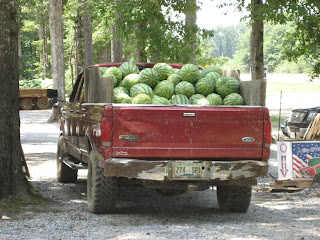In lieu of Oxford and Clarksdale, I decided that after a long Friday night it would be best to minimize my Saturday travels and explore Vicksburg, Mississippi in more depth.
 The last time I visited Vicksburg, a few friends and I attended the lavish—in a southern sense, complete with all the heart-clogging fixings—opening of a traveling Smithsonian exhibition chronicling the history of the Blues. This time, however, I sought out to see this quaint town nestled one of myriad bends on the Mississippi River. Before stopping in Vicksburg, I felt an outstanding obligation to permit my car, even if for the most fleeting of moments, to experience the “West.” My 1998 Honda Accord, in other words, crossed the Mississippi River into Louisiana, exited the highway, re-entered the highway, and then returned to Vicksburg for some sightseeing.
The last time I visited Vicksburg, a few friends and I attended the lavish—in a southern sense, complete with all the heart-clogging fixings—opening of a traveling Smithsonian exhibition chronicling the history of the Blues. This time, however, I sought out to see this quaint town nestled one of myriad bends on the Mississippi River. Before stopping in Vicksburg, I felt an outstanding obligation to permit my car, even if for the most fleeting of moments, to experience the “West.” My 1998 Honda Accord, in other words, crossed the Mississippi River into Louisiana, exited the highway, re-entered the highway, and then returned to Vicksburg for some sightseeing. While it’s known for its relentless Civil War siege and today for the riverboat casinos that dock there, Vicksburg takes phenomenal pride in being the first place that bottled Coca-Cola. Joseph Biedenharn first bottled this mediocre yet wildly lucrative elixir in his charming candy store and soda parlor on Washington Street in 1894; beforehand, it only existed “on tap,” I suppose. Today, the town has immortalized the store as the Biedenharn Coca-Cola Museum, adorned with an extraordinary array of antique bottling equipment and Coke memorabilia, including a collection of coke bottles that if brought up north could accrue a small fortune in 5-cent redeemables. After visiting this oh-so-touristy downtown destination, I stopped by the Attic Gallery, a regionally-renowned gallery of contemporary Southern art. Ascend ding four stories through a catacomb of hallways and rooms, beautiful art inhabits each nook and cranny of this rustic building, from wall to wall and from floor to ceiling.
While it’s known for its relentless Civil War siege and today for the riverboat casinos that dock there, Vicksburg takes phenomenal pride in being the first place that bottled Coca-Cola. Joseph Biedenharn first bottled this mediocre yet wildly lucrative elixir in his charming candy store and soda parlor on Washington Street in 1894; beforehand, it only existed “on tap,” I suppose. Today, the town has immortalized the store as the Biedenharn Coca-Cola Museum, adorned with an extraordinary array of antique bottling equipment and Coke memorabilia, including a collection of coke bottles that if brought up north could accrue a small fortune in 5-cent redeemables. After visiting this oh-so-touristy downtown destination, I stopped by the Attic Gallery, a regionally-renowned gallery of contemporary Southern art. Ascend ding four stories through a catacomb of hallways and rooms, beautiful art inhabits each nook and cranny of this rustic building, from wall to wall and from floor to ceiling. Today, a few friends and I set out for the Smith County Watermelon Festival. There was only one small problem: no watermelon festival existed; it instead took place on Friday and Saturday. We showed up in Mize, Mississippi to a ghost town, similar to all one zillion of Mississippi's small towns on the Lord’s Day. After realizing we had traveled for well over an hour and played the blame game about who exactly flubbed the festival dates, we agreed that it was the Mississippi tourism website’s events calendar that had led us astray. The journey is nonetheless the best part of the trip. We stopped at a roadside watermelon stand and with the help of two of the farmers, learned how to property select, cut open, and properly eat a Smith County watermelon. Over the next several hours, we
Today, a few friends and I set out for the Smith County Watermelon Festival. There was only one small problem: no watermelon festival existed; it instead took place on Friday and Saturday. We showed up in Mize, Mississippi to a ghost town, similar to all one zillion of Mississippi's small towns on the Lord’s Day. After realizing we had traveled for well over an hour and played the blame game about who exactly flubbed the festival dates, we agreed that it was the Mississippi tourism website’s events calendar that had led us astray. The journey is nonetheless the best part of the trip. We stopped at a roadside watermelon stand and with the help of two of the farmers, learned how to property select, cut open, and properly eat a Smith County watermelon. Over the next several hours, we  wandered through a corn field at the brink of harvest, visited the small town of Mendenhall, Mississippi, and stopped at Jerry’s Catfish House, where I ate one of Mississippi’s most famous filleted-and-lightly-battered catfish.
wandered through a corn field at the brink of harvest, visited the small town of Mendenhall, Mississippi, and stopped at Jerry’s Catfish House, where I ate one of Mississippi’s most famous filleted-and-lightly-battered catfish.I’ve returned to Jackson not only more cultured, but well-fed and with enough watermelons in tow to supply Gallagher and his bizarrely comedic act for quite some time.









